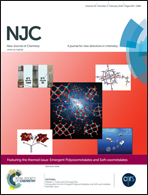Off–on fluorometric detection of cyanide anions in an aqueous mixture by an indane-based receptor†
Abstract
We synthesized an indanedione–coumarin dyad (1) and used it as an off–on type fluorescent receptor for rapid, selective, and sensitive detection of CN− in an aqueous mixture. The receptor itself shows very weak fluorescence from the coumarin moiety due to the photoinduced electron transfer (PET) from the photoexcited coumarin to the indanedione moiety. Selective nucleophilic addition of CN− to the β-carbon of the receptor suppresses the PET and results in strong fluorescence enhancement. The reaction mechanism was fully confirmed by 1H, 13C NMR, Job's plot, and FAB-MS analysis. The receptor successfully detects CN− as low as 25 μM within 20 min.


 Please wait while we load your content...
Please wait while we load your content...